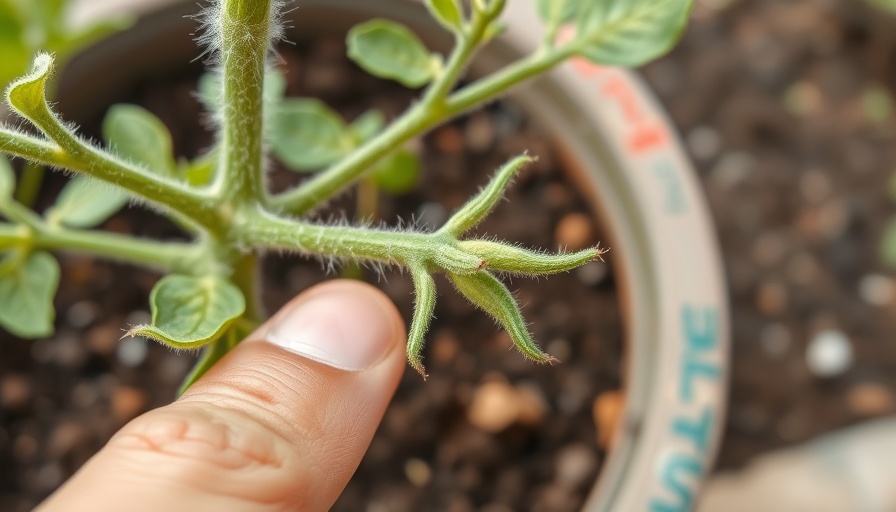
Understanding Tomato Roots: The Basics of Plant Anatomy
For Okanagan gardeners eagerly waiting for that first vine-ripened tomato, understanding the anatomy of their plants can make a significant difference in their gardening practices. While many enthusiasts may notice those intriguing white bumps on the roots of tomato plants, it’s essential to know what these structures are. Contrary to common belief, these bumps are not what we refer to as root hairs; they are actually something called trichomes. Recognizing the difference between these two root structures is vital for anyone serious about growing healthy vegetables.
In 'They Are NOT Roots', the discussion dives into the distinctions between trichomes and root hairs, exploring key insights that sparked deeper analysis on our end.
What Are Trichomes and Their Role?
Trichomes are tiny hair-like structures found on the surfaces of plants, including tomatoes. Their primary function is to provide protection against herbivores and harsh environmental conditions. For instance, trichomes can help reduce water loss by creating a barrier against harsh winds and sunlight. In the case of tomatoes, they also serve as a defense mechanism against pests. Understanding this aspect of plant biology allows gardeners to appreciate how selective cultivation can enhance yield and vigor.
The Importance of Healthy Roots in Gardening
The roots of any plant are foundational to its health and productivity. When gardeners misidentify crucial root structures—like confusing trichomes for root hairs—they may overlook essential care practices required for thriving tomato plants. Healthy roots enable the plant to absorb nutrients and water efficiently, which in turn affects fruit development. Gardeners should focus not only on the visible parts of the plant but also on nurturing a robust root system.
Best Practices for Okanagan Gardeners: Caring for Tomato Roots
If you want to ensure that your tomato plants reach their full potential, here are some actionable insights:
- Soil Quality: Employ high-quality, well-draining soil to encourage healthy root development. Organic matter, such as compost or aged manure, can provide a nutrient-rich environment conducive to growth.
- Proper Irrigation: Water your plants consistently, ensuring the soil remains moist but not overly saturated. Overwatering can lead to root rot, while underwatering can stunt growth.
- Mulching: Applying mulch around your tomato plants can help retain soil moisture and regulate temperature.
These methods will not only support strong trichome growth but also ensure the overall health of your plants.
Common Misconceptions About Tomato Roots
It’s easy to assume that just because roots and root hairs are often visually similar, their functions must be alike. However, recognizing the distinct roles of these structures can redefine how you approach gardening. For example, many gardeners might inadvertently blame trichomes for pest issues or nutrient deficiencies, when in fact, they serve to protect the plant from such challenges.
Gardening Trends: The Rise of Local and Sustainable Practices
With an increasing number of individuals in the Okanagan and beyond turning to home gardening, understanding plant anatomy has never been more critical. This trend reflects a larger movement toward sustainability and self-sufficiency. As more people cultivate their own vegetable gardens, there’s a growing emphasis on organic practices that support local ecosystems while providing fresh produce.
Community Connections: Sharing Knowledge and Resources
This focus on gardening also fosters a sense of community among Okanagan residents. Local gardening clubs and online forums provide opportunities to share tips and experiences, helping others learn from successful practices. Engaging with fellow gardeners can illuminate diverse perspectives on managing pests, enriching soil, or even simply swapping seedlings to enhance variety.
Final Thoughts: The Joys of Growing Your Own Tomatoes
For Okanagan gardeners, understanding the intricacies of tomato plant anatomy—like distinguishing trichomes from root hairs—can dramatically enhance gardening success. As these plants mature under the right conditions and with informed care, the anticipation of a rich harvest becomes that much sweeter. Experience the joy of nurturing your own tomatoes, and don't forget to share your triumphs and challenges with the gardening community. Together, we can cultivate a rich culture of gardening that thrives on knowledge, sustainability, and community spirit.
 Add Row
Add Row  Add
Add 




 Add Row
Add Row  Add
Add 

Write A Comment